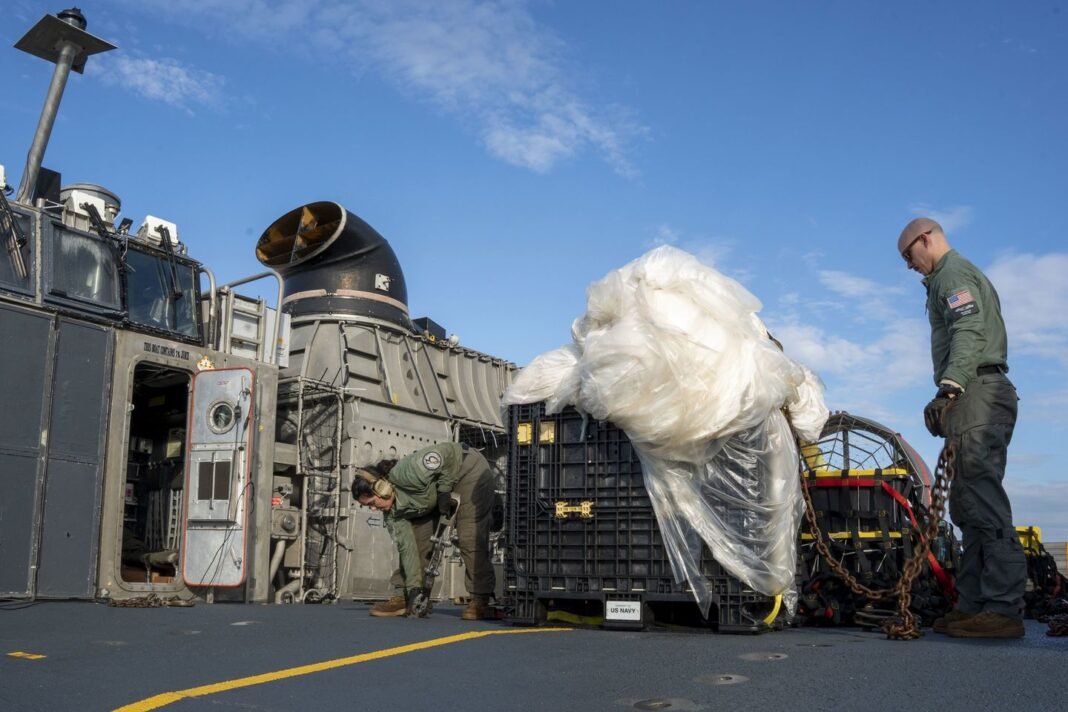The Daily Observer London Desk: Reporter- Jack Brumby
The Biden administration on Monday seemingly ruled out an alien invasion as the explanation for three weekend shoot-downs of unidentified objects over North America.
Beyond that, however, there are still far more questions than answers about the crafts themselves and, perhaps more importantly, about the potentially serious gaps in U.S. airspace security they may have exposed.
National security specialists say the defense of American airspace deserves a “stringent review” after the events of the past three days, which are virtually unprecedented in U.S. history and have stoked fears that the nation may be under attack. Pentagon officials acknowledged that never before in American history has the U.S. taken “kinetic action” against an object in North American airspace — let alone three times in three days and four times in just over one week.
Secretary of Defense Lloyd Austin told reporters in Brussels Monday evening that the three objects shot down over the weekend in Alaska, Canada’s Yukon Territory, and over Lake Huron — all still of undetermined origin — had not presented a danger to anyone on the ground. But he insisted the crafts did present a risk to civil aviation and potentially an intelligence-collection threat.
“Because we’ve not been able to definitely assess what these recent objects are, we’ve acted out of an abundance of caution to protect our security and interests,” Mr. Austin said, who added no debris had been yet collected from the three recent shootdowns. “We have teams working hard to track down the debris from over the weekend. Each of these recoveries is unique and each poses their own challenges.”
In its own remarks on the controversy, the Biden administration went out of its way to rule out at least one possibility.
“I just wanted to make sure we address this from the White House: I know there have been questions and concerns about this but there is no — again no — indication of aliens or extraterrestrial activity with these recent takedowns,” press secretary Karine Jean-Pierre told reporters on Monday.
The Biden administration also announced Monday that it will form an interagency team to address the unusual flying objects in the skies above North America, while Britain said Monday it would conduct a review of its own aerial defenses in light of the North American incidents.
Defense Secretary Ben Wallace said in a statement that “the U.K. and her allies will review what these airspace intrusions mean for our security.”
“This development is another sign of how the global threat picture is changing for the worse,” he warned.
The whirlwind period began with the cross-country flight of a massive Chinese surveillance balloon that was ultimately shot down off the South Carolina coast on Feb. 4. The saga continued Friday and Saturday when U.S. F-22 fighters shot down unidentified, unmanned objects off the Alaskan coast and in Canada’s Yukon Territory, respectively, and with Sunday’s dramatic takedown of an octagonal object over the waters of Lake Huron.
While the craft were different sizes and flying at different altitudes, all four were moving west to east across North America, leading Canadian Prime Minister Justin Trudeau to speculate that they’re connected.
“Obviously, there is some sort of pattern in there. The fact we are seeing this in significant degree over the past week is a cause for interest and close attention, which is exactly what we’re doing,” Mr. Trudeau said during a press conference Monday in the Yukon.
Crews continued searching Monday for wreckage in the Yukon and at the other shoot-down locations, and officials said those recovery efforts will eventually provide more answers about each of the craft. It’s still not clear whether the three weekend objects may also be foreign spy machines similar to the large Chinese balloon. U.S. lawmakers suggested over the weekend at least two of the objects appear to be balloons, but the Pentagon has not offered any definitive explanations so far.
For its part, Beijing on Monday tried to change the narrative and deflect blame back onto the U.S., accusing Washington of flying its own spy balloons over China.
“Since last year, U.S. high-altitude balloons have flown over Chinese airspace over ten times without authorization from China,” Wang Yi, the ruling Communist Party’s top foreign policy official, said in a translation posted by the Chinese government. “The U.S. needs to reflect on its own behavior and change course rather than attacking others and stoking confrontation.”
The spokesman did not elaborate on where the purported balloons were found or their purpose.
The White House rejected Beijing’s claims.
“We’re not flying surveillance balloons over China. I’m not aware of any other craft that we’re flying into Chinese airspace,” National Security Council spokesman John Kirby told reporters at a White House briefing.
Mr. Kirby also said that, despite China’s recent refusal to take a call from Mr. Austin to discuss the surveillance balloon shooting, the two capitals were still able to communicate.
“People shouldn’t take away from this that all communication has been severed between the United States and China, that Beijing and Washington aren’t talking,” Mr. Kirby said. “… Unfortunately, the Chinese military is not interested in talking to [Mr. Austin], but there are still ways to communicate and the president would tell you that now’s exactly the time to at least preserve some of those lines of communication, so that we can avoid miscalculation or set back the relationship.”
Searching for answers
While Mr. Trudeau cited the similarities, there are also major differences between the objects.
The three craft shot down over the weekend were much smaller and were flying at much lower altitudes than the Chinese spy balloon, and they did not seem to have any surveillance equipment on board. They also differed from the original balloon in that they did not appear able to maneuver or change direction on their own.
U.S. pilots gathered as much first-hand information about the craft as possible before President Biden gave the orders to shoot them down.
“We assessed whether they were sending any communications signals,” Mr. Kirby told reporters Monday. “We detected none. We looked to see whether they were maneuvering or had any propulsion capabilities. We saw no signs of that.”
And, he added, “we made sure to determine whether or not they were manned. They were not.”
Analysts say that the three shoot-downs served a dual purpose of both protecting civilian air traffic from potentially dangerous airborne intruders while also signaling to Beijing and other potentially hostile states that the U.S. has become hypervigilant to any potential threats from above.
But they also have revealed that the U.S. must make immediate improvements to its handling of aerospace security.
“Strategically, there is real utility in making it clear to adversaries that the U.S. is willing to use lawful force to defend its territorial airspace,” said retired Air Force Gen. Charles J. Dunlap Jr., now the executive director of the Center on Law, Ethics and National Security at Duke University. “Just based on what’s in the media, the legal argument for doing so in these cases appears strong. That all four of these objects were downed with no apparent loss of life or much property damage is remarkable, and indicates that the intercepts were carefully planned and expertly executed.”
Indeed, U.S. Northern Command and NORAD chief Gen. Glen VanHerck spoke frankly about the gaps in American airspace awareness during a hastily arranged press conference on Sunday evening. He said that U.S. military personnel initially found an unidentified object in the skies over Montana late Saturday evening but later lost track of it, before eventually picking up what they believed to be the same object over Wisconsin on Sunday morning. That object was shot down later Sunday over Lake Huron.
“At sunset, we were unable to find the track. Also, our radar operators lost the track on radar. And the FAA was never tracking the radar,” Gen. VanHerck told reporters. “Therefore, that’s why we called it an anomaly because we weren’t able to identify it.”
From a national security perspective, there is a mix of good news and bad news with respect to North American radar capabilities. On the plus side, officials said that the U.S. tweaked its capabilities on the heels of the controversy sparked by the Chinese spy balloon flyover. That has allowed NORAD to better track objects flying at lower altitudes and relatively slow speeds.
“One of the reasons that we think we’re seeing more is because we’re looking for more,” Mr. Kirby said.
At the same time, officials have said that it is exceedingly difficult to track relatively small objects moving at slow speeds through the skies. It is that gap in capabilities that is surely being examined right now inside the Pentagon.
China has accused the Biden team, under heavy pressure from critics in Congress, of overreacting to the first balloon intrusion, abruptly canceling a planned fence-mending trip by Secretary of State Antony Blinken to Beijing slated to start the day after the balloon was downed.
And the Pentagon has faced questions over why it refused to act publicly against the Chinese craft until it was spotted and publicized by civilians as it floated in the airspace above Montana.
Lt. Gen. Alex Grynkewich, head of Air Force operations at the Pentagon’s Central Command covering the Middle East, told a think tank roundtable Monday that U.S. forces in the Middle East had spotted a Chinese stratospheric balloon floating through the region last fall, though it did not pass over any “sensitive” military sites and was not seen as a threat.
Chinese balloons periodically fly over U.S. Central Command, with no particular pattern, Lt. Gen. Alex Grynkewich told a group at the Center of a New American Security, the Associated Press reported.
And Mr. Austin insisted that, despite the flurry of shootdowns, the Pentagon was not adopting a new approach to the threat.
While U.S. jet fighters have shot down four objects floating over the U.S. and Canada within the past several days, Mr. Austin denied that the newly-aggressive stance reflected a fundamental change in policy.
“We will evaluate each and every event on its own merit and will make a decision based on the recommendations,” Mr. Austin said. “We want to make sure that we have the ability to examine what these things are and potentially what they’re doing.”
— Jeff Mordock, Mike Glenn and Tom Howell Jr. contributed to this report, which is based in part on wire service reports.



